
The Confederation of Indiana.
The Confederation of Indiana was one of the five original confederations that made up the Confederation of North America under the Britannic Design of 1781. Its capital and largest city is Michigan City. Other notable Indianan cities are Fort Radisson, the first capital; Brant, the site of the Brant Convention of 1841; and the industrial centers of New Boston and Kent. The chief executive is the Governor of Indiana and the legislature in the Indiana Council.
Creation and Growth[]
The area that would become Indiana was subject to conflicting territorial claims by the colonies of Massachusetts, Connecticut, New York, and Virginia before being added to Quebec by the Quebec Act of 1774. In the deliberations in Parliament over the Britannic Design in 1780, it was decided that Indiana would be separated from Quebec and formed into a separate confederation with its capital at Fort Radisson. The first Governor of Indiana (or Governor-General, as the office was originally known) was Pierre Concordé, who was sworn in at Fort Radisson on July 2, 1782.
Fur traders in Indiana sought to expand their range across the Mississippi to Spanish Louisiana, and when the Trans-Oceanic War broke out between Great Britain and Spain in 1795, the news was greeted eagerly in Fort Radisson. By the late summer of 1798, British troops and Southern Confederation militia had defeated the Spanish and their Indian allies, and Louisiana was annexed to the C.N.A. and organized into the new confederation of Vandalia.
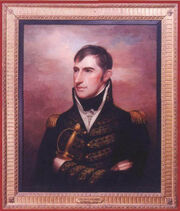
William Henry Harrison.
White settlers had been arriving in Indiana since before the outbreak of the North American Rebellion, and had led to the outbreak of Lord Dunmore's War in 1774. Settlement continued and increased after the Rebellion, and by the 1790s the Indian tribes of Indiana were becoming alarmed. Starting in 1803, Chief Tecumseh of the Shawnee began gathering the Indians of Indiana and eastern Vandalia, including the Iowa, Missouri, Dakota, and Osage nations, into a united confederacy. Tecumseh defeated General William Henry Harrison at the Battle of Twin Forks in 1810, and wiped out another Indianan army at Bloody Creek in 1811. Harrison was forced to call upon the eastern confederations for assistance in 1814 when Tecumseh's forces threatened to take Burgoyne. After 1815, the combined armies of Indiana, the Northern Confederation, and the Southern Confederation were able to drive back the Indians, although Tecumseh was never defeated in open battle. Thanks to Tecumseh, the Indians would remain a threat to the confederation's white settlers for the next four decades, and all Indianan cities had external fortifications.
Chief Miller's War[]
In spite of the Indian threat, the population of Indiana grew quickly in the early 19th century, rising from 250,000 in 1810 to 3.5 million in 1840. By 1840, Michigan City had a population of 500,000, attracting businessmen from the Northern Confederation with the promise of commercial and mercantile wealth. Other industrial and commercial centers appeared in the cities of Kent and New Boston. Although visitors from the eastern confederations and Europe complained that Indianan cities were rustic and lacked culture, the proximity to the frontier gave them a vitality lacking in more settled cities.
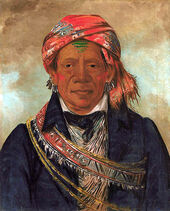
Chief John Miller.
Tecumseh's death led to the dissolution of his confederacy of Indian nations, but in the late 1830s Chief John Miller of the Osage was able to revive it. Miller, a convert to Christianity, proclaimed himself to be both the Messiah and the ghost of Tecumseh. He claimed that whites were the agents of the devil, and he promised to establish an earthly paradise in North America after they had been destroyed. Thousands of Indians in Indiana and Vandalia joined his army, and in the summer of 1839 he launched his holy war against the whites by marching on Michigan City. After a two-week seige, Miller's army took the city on 21 July 1839, which the celebrated by killing 5,000 of its inhabitants.
News of the fall of Michigan City reached Burgoyne within days, prompting the Viceroy, Sir Alexander Haven, to call an emergency meeting of the Grand Council. The Council agreed to the formation of a united North American army, placing General Winfield Scott of Indiana in command. Scott was able to reach Michigan City on 18 October, and the next day he entered the city, overrunning Miller's army, then carrying out a mass slaughter of his Indian prisoners. An inquiry was held on Scott's actions which revealed that he had ordered his officers to take no prisoners. However, Scott was acquitted of any wrongdoing, and he became a national hero.
Rocky Mountain War and the People's Coalition[]
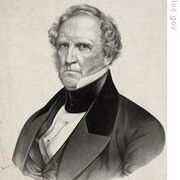
Winfield Scott.
Scott was one of the leading figures when delegates of the Liberal Parties of the four major confederations met in Concordia, North Carolina in July and August 1841 to draft a proposal for a revision of the Britannic Design. The troubles suffered by all four confederations in the Crisis Years led the delegates to support the creation of a more unified, centralized C.N.A. In response to the Concordia Convention, the Conservatives held a convention of their own in the Indianan city of Brant in September, where they echoed the Liberals' call for a more unified nation. This resulted in the Burgoyne Conference of 1842, which drafted the Second Britannic Design.
Under the Second Design, the Grand Council was transformed into a national legislative body of 150 members, with Indiana electing twenty-four. The first elections under the Second Design were held in February 1843. Scott became the leader of the Unified Liberal Party, and he was able to use his popularity with the white settlers of Indiana to gain the U.L.P. seventeen of the confederation's seats. When the newly-elected Council met for the first time, the U.L.P. had 91 seats, and Scott was chosen by them to be the first Governor-General of the C.N.A.
Despite Scott's general popularity, his Minister of War, Henry Gilpin of the Northern Confederation, had more power within the U.L.P. Against Scott's wishes, Gilpin was able to maneuver the C.N.A. into a war with the United States of Mexico in September 1845. During the war, an Indianan army led by General Harry Chapin occupied the northern half of the Mexican state of Mexico del Norte, though several attempts to take the Norteño capital of Conyers were unsuccessful. Chapin's aide, General Kenneth Parkes of New York, served as Military Governor of the occupied territory until 1853, when he was elected to the Grand Council. Parkes was able to gain a Liberal majority in the 1858 Grand Council elections by blackmailing five councilmen from Indiana. Herbert Clemens, a wealthy businessman and Grand Council member from Michigan City, was able to use his personal wealth to gain a Conservative majority in the 1868 Grand Council elections. Clemens sponsored the Reform Bill of 1870, which redistributed seats in the Grand Council. Under the 1870 bill, Indiana's seats increased from twenty-four to twenty-nine.
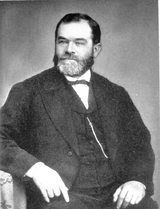
Patrick Gallivan.
A railroad boom during and after the war led to the growth of the Indiana Northern Railroad under Patrick Gallivan, an Irish immigrant who settled in Michigan City after the war and had risen to become its president by 1861. Gallivan was able to extend the line into Manitoba to the northwest, and after 1877 into Southern Vandalia, and then south from there to link to the Jefferson & California Railroad in the U.S.M.
In the 1870s, wealthy Indiana wheat farmers formed the Indiana branch of the newly-established People's Coalition, and in the 1873 Grand Council elections were able to win four of the confederation's seats, against eight for the Liberals and seventeen for the Conservatives. Five years later, the P.C. increased its delegation by six seats, and the Liberals by one, at the expense of the Conservatives. Liberal leader John McDowell of Manitoba was able to form a minority government with the help of reformers from the other parties.
A major flood in 1881 destroyed much of Fort Radisson and led to movement of the capital of Indiana to Michigan City. In 1882 Ezra Gallivan, the thirty-three-year-old son of Patrick Gallivan, was elected Mayor of Michigan City on the People's Coalition ticket. Gallivan emerged as one of the leaders of the Coalition at the 1883 nominating convention in Boston, and in the 1888 Grand Council elections, the Coalition under Gallivan won a majority of Indiana's seats, leading to a plurality in the Grand Council, and a P.C. government led by Gallivan.
Gallivan and Kronmiller[]
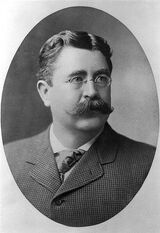
Ezra Gallivan.
In his inaugural address, Gallivan pledged that "new means will be found for the people to . . . share more fully in the profits their work made possible." His means for doing so was to transform the National Financial Administration into a government-run commercial bank, offering low-interest loans to start-up businesses. Under Administrator Julius Nelson, the N.F.A. increased its financings from 21 in 1889 to 341 in 1901. Among its earliest successes was Indiana Milling, Ltd., which became one of the C.N.A.'s major flour producers.
Gallivan's programs proved too moderate for many within the P.C., and in the 1893 Grand Council elections, an Indianan union official named Thomas Kronmiller won a seat, and became the leader of the radical wing of the People's Coalition. Kronmiller was an adherent of the Moral Imperative, and he sought war with the U.S.M. to free that country's Negro slaves. This conflicted with Gallivan's isolationism, and when the Mexicans won a series of stunning victories against the Russian Empire in the Great Northern War of 1898 - 1901, Kronmiller took advantage of the hysteria that swept the C.N.A. to agitate for war with Mexico, and for Gallivan's ouster. Although Kronmiller succeeded in driving Gallivan out of power in July 1901, he proved too contentious for the P.C. caucus in the Grand Council, which chose the moderate Clifton Burgen instead. In the 1903 Grand Council elections, Gallivan was able to win the Coalition's nomination for his protégé Christopher Hemingway, who went on to win twenty-one of Indiana's thirty-four seats, and an eighty-three seat majority in the Council. When Kronmiller sought the annexation of the Caribbean island nations of Cuba and Porto Rico, Hemingway was able to thwart him.
Dewey and Galloway[]

Owen Galloway.
Michigan City was home to Galloway Locomobile, Ltd., a locomobile company founded in the late 19th century by Samuel Galloway, the great-great-grandson of Joseph Galloway. Under Samuel Galloway's son, Owen Galloway, Galloway Locomobile would become North American Motors in 1921, the largest business enterprise in the C.N.A.
A malaise spread through the C.N.A. after the Chapultepec Incident of January 1916, prompted by a growing dissatisfaction with industrial civilization. Governor-General Calvin Wagner of Indiana was unable to cope with the situation, which had degenerated into violent civil disturbances by the summer of 1922. The malaise was successfully dealt with by Galloway, who in December 1922 announced the Galloway Plan, which used the wealth of North American Motors to subsidize emigration within and from the C.N.A. The result was a surge of emigration from the industrial cities of Indiana and the Northern Confederation to the sparsely-settled plains of Manitoba.
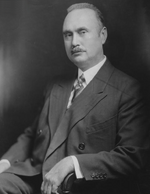
Henderson Dewey.
Galloway became the most popular man in the C.N.A., and although he did not seek political office himself, Councilman Henderson Dewey of Indiana was able to take advantage of Galloway's popularity. Dewey embraced Galloway's programs, and even his style, which allowed him to lead the Liberals to victory in the 1923 Grand Council elections. Dewey continued to take advantage of Galloway's popularity while in office, meeting with him eight times during his first term in office, and telling reporters that he "wanted to draw upon the wisdom of this great man." On four different occasions, Dewey asked Galloway to serve as chairman of special commissions, though Galloway always refused. Dewey even offered in 1927 to step down and support Galloway as the Liberal candidate for governor-general, though Galloway again refused. Dewey also continued to imitate Galloway's style, speaking in the same low-key manner as Galloway, and introducing legislation quietly via Liberal back-benchers.
Recession and War[]
Dewey was able to lead the Liberals to another victory in the 1928 Grand Council elections, winning twenty of Indiana's thirty-two seats as part of a ninety-four seat Council majority. He continued his program of decentralizing political and economic power from the national government to the confederations, creating a commission to suggest reforms of the N.F.A. However, before he was able to introduce his N.F.A. legislation, he died in his sleep on the morning of 10 May 1929.
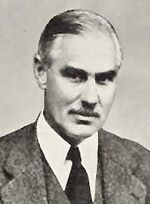
Douglas Watson.
Dewey's successor, Douglas Watson, was able to push through his reform of the N.F.A. in 1930, and the agency was broken up into confederation-level subagencies, while increasing its start-up business loans. However, a financial panic sparked by the international corporation Kramer Associates led to the bankruptcy of the N.F.A., including the Indiana branch, on 16 March 1936, followed by a severe worldwide recession.
The recession continued until the outbreak of the Global War in October 1939, when arms manufacturing and farm subsidies returned prosperity to the C.N.A. The country remained neutral under Governor-General Bruce Hogg, until a general exhaustion of the combatant nations brought the war to a de facto close in 1948.
The continued enmity of the combatant nations, especially between Mexico and Kramer Associates, led to the postwar period being known as the War Without War. After K.A. built and detonated an atomic bomb in 1962, an atomic arms race took place among the other major powers. The discovery of a Mexican spy ring in Michigan City in 1969 led to a diplomatic crisis between the two countries, and a series of border clashes by 1971.
Sobel's sources for the Confederation of Indiana include Harrison's Autobiography (Burgoyne, 1840); Colonel Harry Warner's The Michigan City Inquiry: Scott and the Nation (New York, 1906); James Paulding's The Indian Question in Indianan Foreign Policy (New York, 1959) and One State, Two Nations: Indianan and Indian (New York, 1967); James Barrett's Counting the Cost: The Legacy of Tecumseh (Mexico City, 1960); Frank Cockrill's What Happened at Michigan City? (London, 1968); and Henry Brand's Tecumseh and the Indianan Wars (New York, 1970).
This was the Featured Article for the week of 27 July 2014.
| Governors of Indiana |
|---|
| Pierre Concordé • William Henry Harrison • Claude Baldwin • Joseph Fellows • Maxwell Boatner • David Heald |
| Confederations of the C.N.A. |
|---|
| Central Confederation • Indiana • Manitoba • Northern Confederation • Northern Vandalia • Quebec • Southern Confederation • Southern Vandalia • Vandalia |
